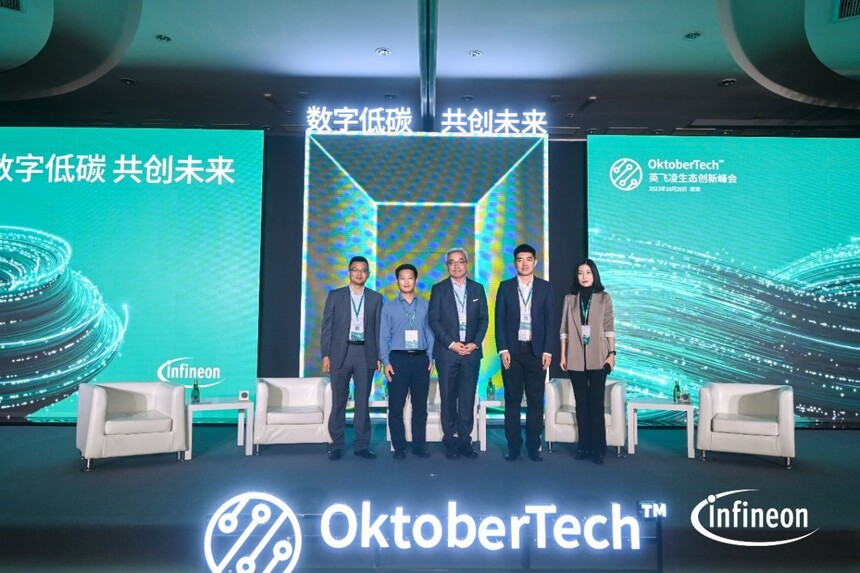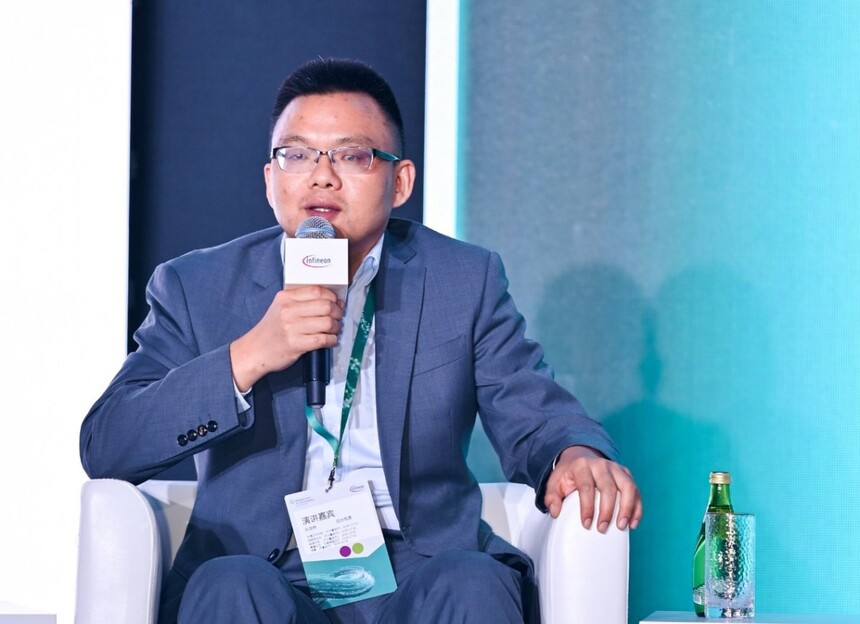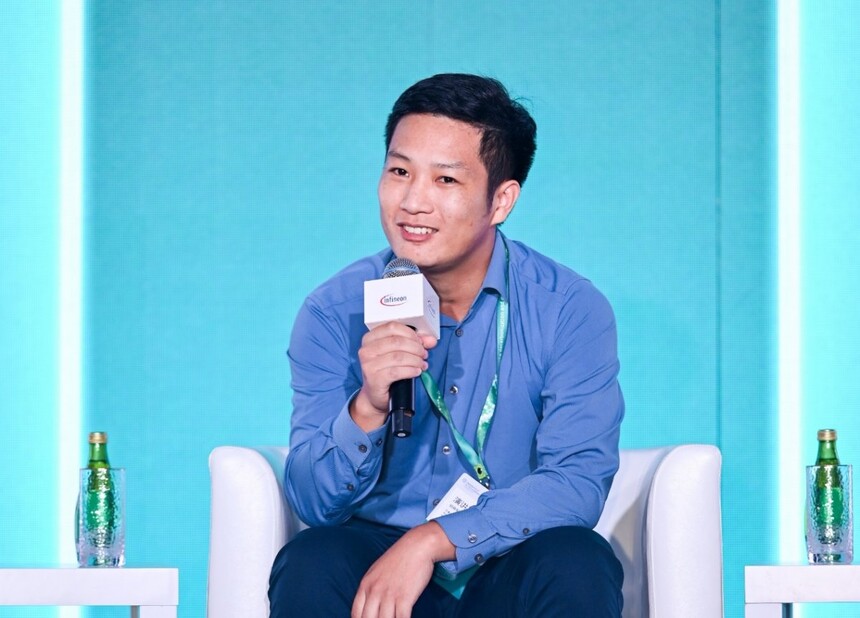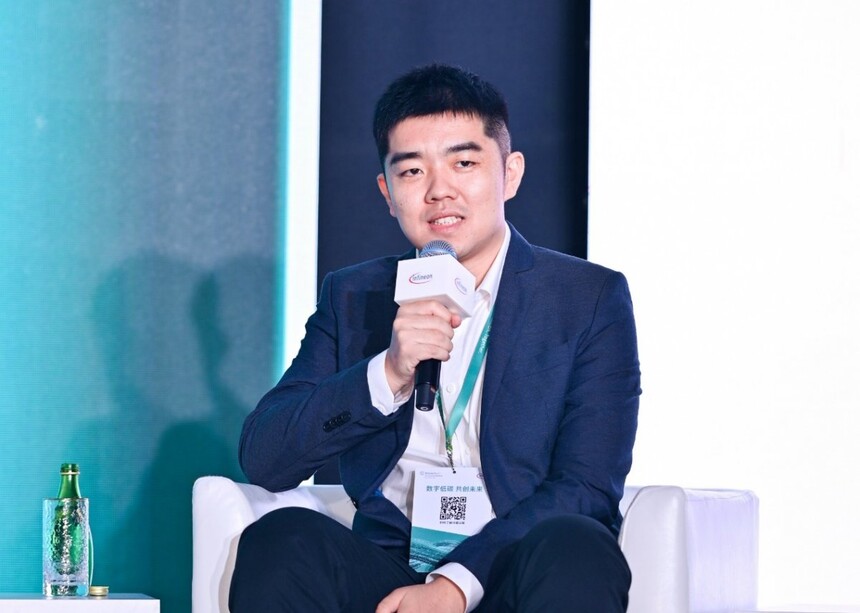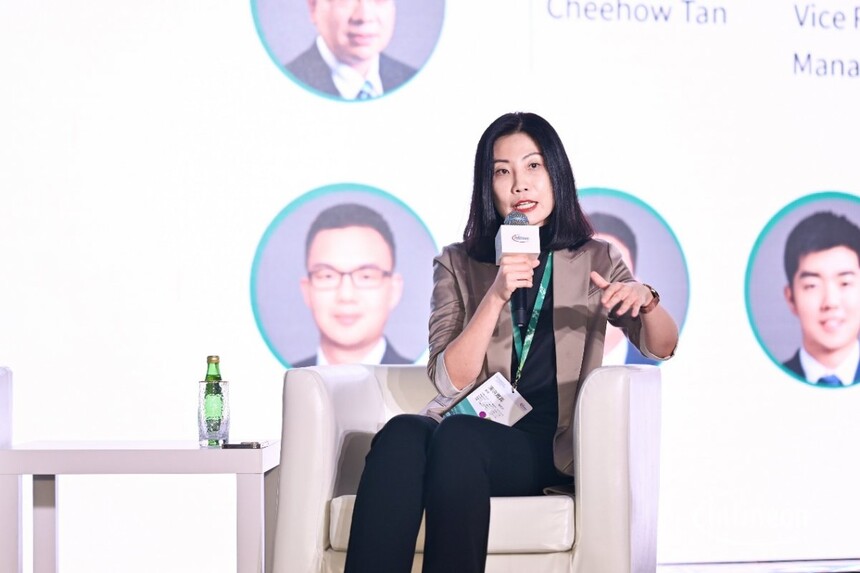|
Innovation cooperation and integrated development of the semiconductor industry under the trend of digital low-carbonTime:2023-11-02 In Infineon's view, the next decade is an era of low-carbon and digital "dual wheel drive" development. Especially in China, low-carbon and digitalization are important engines driving economic growth and social progress. So, how can we leverage the power of semiconductor technology to drive low-carbon and digital transformation? This is a topic of great concern in the industry.
Guests of the Round Table Forum (from left to right): Sun Longlin, R&D Director of Sunshine Hydrogen Technology Co., Ltd; Hu Senjun, Senior Marketing Director of Fute Technology; Chen Zhihao, Vice President of Infineon Power and Sensing Systems Business Unit in Greater China and Managing Director of Infineon Taiwan (chaired) Sun Jie, founder and CEO of Dahuan Robotics; Peng Zhao, founder of Zhichifang. Low carbonization and digitization are the trendAt the beginning of the discussion, Chen Zhihao briefly reviewed the development of the entire macroeconomy in 2023. He pointed out that after the epidemic, the entire economy is slowly recovering, and artificial intelligence has been comprehensively promoting the digital development of the entire market. More and more industries and enterprises are attaching importance to sustainable development and low-carbon digitization, and actively promoting related deployments. Meanwhile, various fields such as green energy, electric vehicles, artificial intelligence, and data centers are influencing the entire semiconductor industry in various aspects.
Chen Zhihao, Vice President of Infineon Power and Sensing Systems Business Unit in Greater China and Managing Director of Infineon Taiwan Sun Longlin, R&D Director of Sunshine Hydrogen Technology Co., Ltd., interprets the trend of low-carbon and digitalization from an energy perspective. He stated that hydrogen, as a clean fuel for global energy transformation, can showcase its capabilities in fields such as electricity, industry, and transportation. In the field of electricity, low-carbon emissions reduction, wind power, photovoltaics, hydropower, and other renewable energy sources are now a clear direction. Especially for photovoltaics, the price of photovoltaic modules has recently fallen below the threshold of 1 yuan per watt. So the continuous decline in component prices will greatly promote the development of the photovoltaic industry. In the industrial field, hydrogen gas and hydrogen energy may be used. The emission reduction involved here may be the production of green hydrogen from green electricity, which is generated through renewable energy generation. The carbon content of green hydrogen produced through electrolysis of water is very low. So this is also a feasible solution for carbon reduction. In other areas such as transportation, hydrogen powered buses and passenger cars may be used, including the hydrogen powered train demonstration project currently launched in Germany. "I think the application trend of hydrogen energy in the above three fields is becoming increasingly clear, and the next step is to rely on the continuous efforts of the industry. This is a matter of time," Sun Longlin concluded. According to the data, Sunshine Hydrogen Technology Co., Ltd. is a wholly-owned subsidiary of Sunshine Power Co., Ltd., focusing on research on renewable energy electrolysis hydrogen production technology.
Sun Longlin, R&D Director of Sunshine Hydrogen Technology Co., Ltd Sun Longlin, R&D Director of Sunshine Hydrogen Technology Co., Ltd., has been driving the energy revolution in China in recent years, with the most significant achievement being the vigorous promotion of the popularization of new energy vehicles. Fute Technology is a national high-tech enterprise specializing in high-voltage core components of new energy vehicles, with unique insights in the fields of new energy vehicles and charging. Hu Senjun, Senior Marketing Director of Fute Technology, said that there is no doubt about the help of new energy vehicles in reducing emissions, which is basically zero emissions or very low emissions. On the other hand, in the manufacturing process of new energy vehicles and the emissions from their power generation side, there is still controversy due to the different energy situations in different countries. Based on the overall emission reduction target and the policies of various countries, the penetration rate of electric vehicles in China is expected to reach over 30% this year. If optimistic, the average penetration rate (on the retail side) can reach 35%. The penetration rate in Europe has reached 20%, while in North America it is slightly lower.
Hu Senjun, Senior Marketing Director of Fute Technology Hu Senjun, Senior Marketing Director of Fute Technology, shared some low-carbon and digital innovations from a manufacturing perspective with Dahuan Robotics in the field of intelligent manufacturing. Sun Jie, founder and CEO of Dahuan Robotics, said, "From the perspective of the energy industry chain, Dahuan Robotics is more of a user end of energy. In other words, there are still many links in the manufacturing and production of the entire industry that can achieve the digital and low-carbon goals we need. There is a big premise here: we hope to maintain our production capacity unchanged, or to consider reducing carbon emissions and energy consumption while improving it. The essence of this is to reduce costs and increase efficiency." The biggest challenge in reducing costs and increasing efficiency is how to identify which positions in the entire production process are the most consumed or wasted. This is often inconsistent with what people know and think, known as survivor bias. So how to achieve low-carbon energy consumption? Sun Jie believes that there are two aspects that are very important: first, the issue of awareness. Throughout the entire production process, do everyone equally realize the need to use lower energy consumption to achieve the same production capacity? Secondly, today's theme is digitization. Digitization is the prerequisite and foundation for achieving low-carbon. If each link monitors its carbon emissions, electricity consumption, or energy consumption, and how much energy is effectively generated, it can more efficiently implement emission reduction.
Sun Jie, Founder and CEO of Dahuan Robotics The Internet of Things is closely related to low-carbon and digitalization. Peng Zhao, founder of Zhichifang, said, "There is a seamless connection between low-carbon and digitalization. Digitalization emphasizes improving efficiency, while low-carbon measures efficiency more directly in a quantifiable and measurable way." She added that Zhichifang has always been an observer of the industry and has conducted a lot of market research, including exchanging ideas with Infineon to explore the development of the Internet of Things industry. There is now a term called "digital green integration", which refers to the integration of digitalization and green. Zhichifang is also focusing on the entire loop of green to see at which levels digitalization can be more deeply involved. This map and index are expected to be released by the end of this year.
Peng Zhao, founder of Zhichifang How to improve China's intelligent manufacturing?The improvement of China's intelligent manufacturing industry has been a topic of discussion in recent years. Firstly, the scale of China's manufacturing industry is very large, with the most comprehensive industrial categories in the world. But intelligent manufacturing cannot just be huge, it will also be powerful in the future. How to implement it specifically? Sun Jie believes that from the perspective of the entire manufacturing process, digitization and low-carbon are the necessary paths - producing higher performance products with less energy and monitoring each link more efficiently, which is a very important deployment. "There will be many challenges in this process, and I think the biggest challenge at present is the demand side. To truly promote industrial transformation and development, there needs to be a very clear demand, which must be a broad demand, such as smartphones in the consumer electronics industry, everyone needs them; and this demand must be constantly iterated, such as smart cars now," said Sun Jie. So, intelligent manufacturing requires a new technological revolution to bring about new changes and drivers, while promoting further restructuring of the entire industry chain. For example, recently popular AI, large models, and ChatGPT have significantly improved computing power, which can indeed reconstruct many related aspects of production and manufacturing. So the next one? And even many of them below? This requires the efforts of the entire industry to continuously explore the technologies and directions that can truly promote industrial restructuring. What are the requirements of AIoT for semiconductors?AIoT encompasses many industries, so everyone's needs are also diverse. If we mention the three most crucial points, Peng Zhao believes that the demand in the AIoT industry is intelligence, low power consumption, and security, which are common requirements in the AIoT field. Let's talk about intelligence first. In the Internet of Things industry, many machines and equipment require intelligent capabilities, so many semiconductor companies that make communication modules or other types also integrate intelligent functions and add AI. The second one is low power consumption, as many devices in the IoT industry or AIoT field require power supply, and even the currently discussed passive IoT. In addition, many devices in the Internet of Things have limited space, so the power supply cannot be so large, and low power consumption is definitely the most direct requirement. Another issue is security. Currently, many AIoT devices are closely related to personal life, such as some devices in smart homes such as speakers, locks, cameras, etc., which are likely to be hacked. There are more such devices in the factory, equipped with basic sensing, collection, and networking functions. If we really do attack and defense exercises, hackers may be able to conquer many things at once. So security is also an aspect that everyone attaches great importance to. Peng Zhao summarized, "I think intelligence, low power consumption, and security are common requirements of AIoT, and this is also a clear market opportunity that requires companies with strong comprehensive capabilities like Infineon to provide corresponding solutions." Digital Low Carbon, Infineon Builds Integrated Innovation EcologyThe final topic of the roundtable discussion is about suggestions and ideas on "Infineon's integrated innovation ecosystem". Sun Longlin pointed out that integrating ecology is the direction for the development of various industries in the future. Ecological integration can promote and facilitate the exchange of resources between upstream and downstream enterprises. Everyone can quickly connect their respective needs, shorten the communication distance, and greatly improve the efficiency of problem-solving. In the future, various industries and links will definitely develop into an ecological integration state. Hu Senjun said that the topic of integration is also very applicable to the field of new energy vehicles, because integration means breaking boundaries, and breaking boundaries means that the original boundaries are obstacles. The current challenges faced by new energy vehicles are enormous and can be approached from two dimensions: The first dimension is a significant change, from the traditional 3-4 year development cycle for passenger cars to the current 1-2 year development cycle for new energy passenger cars. Behind this change, higher requirements have been placed on collaboration between upstream and downstream. The requirements for collaboration are completely different between a three-year cooperation and a one-year cooperation. This is actually a manifestation of integration in the development chain. Another dimension is that currently, passenger car manufacturers generally choose to pursue quantity rather than profit. In this case, cost pressure will gradually pass from the manufacturers to the components. In this context, if everyone can achieve deep integration in product definition, better integration with applications, better product definition, and work together to enhance cost competitiveness, it is also a very good integration point. Sun Jie said that integration and ecology are a particularly good term because they are inherently low-carbon. "We are also collaborating with Infineon and have many security architectures in the automotive field, including chips, which have been validated for decades. With such a development process and related technological accumulation, this model can be fully applied to the development framework for security in the robotics field." Peng Zhao pointed out that the integration has already happened in the field of the Internet of Things, because the chain of end-to-end solutions included in the Internet of Things industry is very long, including end, edge, management, cloud, and usage, layer by layer. No enterprise can truly connect from top to bottom and end to end, and after connecting, each can achieve the ultimate. So it is necessary to cooperate with other enterprises and collaborate and integrate one's own solutions with those of other enterprises. "I have observed that in the process of integration, some foresight may be needed, that is, the leaders between enterprises need to have some foresight, such as respecting the boundaries of the other party, anticipating that there may be friction in certain aspects, and adjusting their own team in advance. I think this is more of a suggestion in terms of implementation, and integration is definitely the trend." Peng Zhao said.
Group photo of Infineon's senior team and ecological partners |

